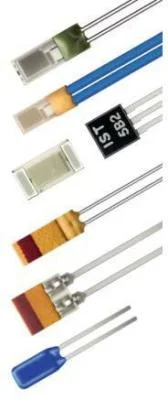Thin Film RTD
A thin film RTD utilizes a ceramic substrate with a small platinum film, which is a highly preferred material for resistance temperature detectors (RTDs).
The notable characteristic of thin film RTDs is their exceptional linearity between resistance and temperature. This exceptional linearity makes thin film RTDs an ideal option for precise and accurate temperature measurements in various applications.
 Image Credit: AZO Materials
Image Credit: AZO Materials
The thin-film RTD offers reliable temperature sensing capabilities across a wide range, spanning from -200°C to +850°C. It is available in both leaded and surface mount device configurations, providing flexibility in installation options.
Moreover, it can be specially designed to operate at temperatures exceeding 850°C.
The thin-film RTD is offered in different resistance values, including 100Ω, 500Ω, and 1,000Ω, catering to diverse application requirements.
Advantages of Thin Film RTD
The followings are the advantages of thin-film RTD.
- The construction of the thin film RTD requires minimal materials, resulting in cost-effectiveness.
- Due to its small size, the thin film RTD is ideal for temperature sensing in various instrumentation and industrial control applications.
- The reduced size of the thin film RTD allows for easy adjustment of resistance, enabling the availability of different resistance options such as 100Ω, 500Ω, and 1,000Ω.
- The sensor’s sensitivity increases with the rise in nominal resistance, enhancing its overall performance.
- The leads of the thin film RTD can be easily connected to instruments through soldering, crimping, brazing, or welding, simplifying the interfacing process.
- Thin film RTDs are available in a wide range of resistance options, enabling a broad spectrum of temperature measurements.
- The thin film RTD has an extensive temperature range for accurate measurement capabilities.
- With excellent repeatability and absence of drift, the thin film RTD consistently provides precise temperature measurements.
- Thin film RTDs are highly robust and unaffected by vibration, making them an excellent choice for environments with significant vibrational activity.
- The thin film RTD boasts an exceptional response time, allowing for rapid resistance changes in response to temperature fluctuations.
- Compared to wire wound RTDs, thin film RTDs offer a more cost-effective solution.
Top 10 Thin Film RTD Manufacturers
Top ten Thin film RTD manufacturers from around the world along with their website addresses are as below.
| Manufacturer Name | Website |
|---|---|
| Honeywell Sensing | https://sensing.honeywell.com/ |
| Vishay | https://www.vishay.com/ |
| TE Connectivity | https://www.te.com/ |
| Omega Engineering | https://www.omega.com/ |
| Emerson Electric | https://www.emerson.com/ |
| Yokogawa Electric | https://www.yokogawa.com/ |
| ABB | https://global.abb/group/en |
| Siemens | https://new.siemens.com/ |
| Rosemount | https://www.emerson.com/rosemount |
| WIKA | https://www.wika.com/ |
Related Articles:
1) What is Temperature Transmitter?
2) Basics of Thermocouples and RTD
3) Burnout Function in Temperature Transmitter
I hope you like above blog. There is no cost associated in sharing the article in your social media. Thanks for reading!! Happy Learning!!


2 Comments